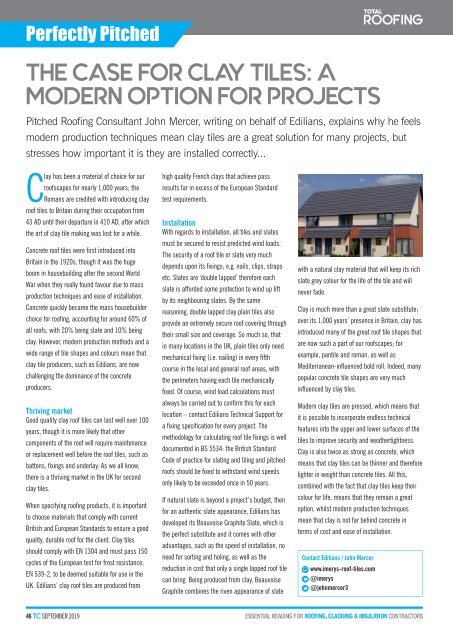September 2019
You also want an ePaper? Increase the reach of your titles
YUMPU automatically turns print PDFs into web optimized ePapers that Google loves.
Perfectly Pitched<br />
THE CASE FOR CLAY TILES: A<br />
MODERN OPTION FOR PROJECTS<br />
Pitched Roofing Consultant John Mercer, writing on behalf of Edilians, explains why he feels<br />
modern production techniques mean clay tiles are a great solution for many projects, but<br />
stresses how important it is they are installed correctly...<br />
Clay has been a material of choice for our<br />
roofscapes for nearly 1,000 years; the<br />
Romans are credited with introducing clay<br />
roof tiles to Britain during their occupation from<br />
43 AD until their departure in 410 AD, after which<br />
the art of clay tile making was lost for a while.<br />
Concrete roof tiles were first introduced into<br />
Britain in the 1920s, though it was the huge<br />
boom in housebuilding after the second World<br />
War when they really found favour due to mass<br />
production techniques and ease of installation.<br />
Concrete quickly became the mass housebuilder<br />
choice for roofing, accounting for around 60% of<br />
all roofs, with 20% being slate and 10% being<br />
clay. However, modern production methods and a<br />
wide range of tile shapes and colours mean that<br />
clay tile producers, such as Edilians, are now<br />
challenging the dominance of the concrete<br />
producers.<br />
Thriving market<br />
Good quality clay roof tiles can last well over 100<br />
years, though it is more likely that other<br />
components of the roof will require maintenance<br />
or replacement well before the roof tiles, such as<br />
battens, fixings and underlay. As we all know,<br />
there is a thriving market in the UK for second<br />
clay tiles.<br />
When specifying roofing products, it is important<br />
to choose materials that comply with current<br />
British and European Standards to ensure a good<br />
quality, durable roof for the client. Clay tiles<br />
should comply with EN 1304 and must pass 150<br />
cycles of the European test for frost resistance;<br />
EN 539-2, to be deemed suitable for use in the<br />
UK. Edilians’ clay roof tiles are produced from<br />
high quality French clays that achieve pass<br />
results far in excess of the European Standard<br />
test requirements.<br />
Installation<br />
With regards to installation, all tiles and slates<br />
must be secured to resist predicted wind loads.<br />
The security of a roof tile or slate very much<br />
depends upon its fixings; e.g. nails, clips, straps<br />
etc. Slates are ‘double lapped’ therefore each<br />
slate is afforded some protection to wind up lift<br />
by its neighbouring slates. By the same<br />
reasoning, double lapped clay plain tiles also<br />
provide an extremely secure roof covering through<br />
their small size and coverage. So much so, that<br />
in many locations in the UK, plain tiles only need<br />
mechanical fixing (i.e. nailing) in every fifth<br />
course in the local and general roof areas, with<br />
the perimeters having each tile mechanically<br />
fixed. Of course, wind load calculations must<br />
always be carried out to confirm this for each<br />
location – contact Edilians Technical Support for<br />
a fixing specification for every project. The<br />
methodology for calculating roof tile fixings is well<br />
documented in BS 5534: the British Standard<br />
Code of practice for slating and tiling and pitched<br />
roofs should be fixed to withstand wind speeds<br />
only likely to be exceeded once in 50 years.<br />
If natural slate is beyond a project’s budget, then<br />
for an authentic slate appearance, Edilians has<br />
developed its Beauvoise Graphite Slate, which is<br />
the perfect substitute and it comes with other<br />
advantages, such as the speed of installation, no<br />
need for sorting and holing, as well as the<br />
reduction in cost that only a single lapped roof tile<br />
can bring. Being produced from clay, Beauvoise<br />
Graphite combines the riven appearance of slate<br />
with a natural clay material that will keep its rich<br />
slate grey colour for the life of the tile and will<br />
never fade.<br />
Clay is much more than a great slate substitute;<br />
over its 1,000 years’ presence in Britain, clay has<br />
introduced many of the great roof tile shapes that<br />
are now such a part of our roofscapes; for<br />
example, pantile and roman, as well as<br />
Mediterranean-influenced bold roll. Indeed, many<br />
popular concrete tile shapes are very much<br />
influenced by clay tiles.<br />
Modern clay tiles are pressed, which means that<br />
it is possible to incorporate endless technical<br />
features into the upper and lower surfaces of the<br />
tiles to improve security and weathertightness.<br />
Clay is also twice as strong as concrete, which<br />
means that clay tiles can be thinner and therefore<br />
lighter in weight than concrete tiles. All this,<br />
combined with the fact that clay tiles keep their<br />
colour for life, means that they remain a great<br />
option, whilst modern production techniques<br />
mean that clay is not far behind concrete in<br />
terms of cost and ease of installation.<br />
Contact Edilians / John Mercer<br />
www.imerys-roof-tiles.com<br />
@imerys<br />
@johnmercer3<br />
46 TC SEPTEMBER <strong>2019</strong>

















